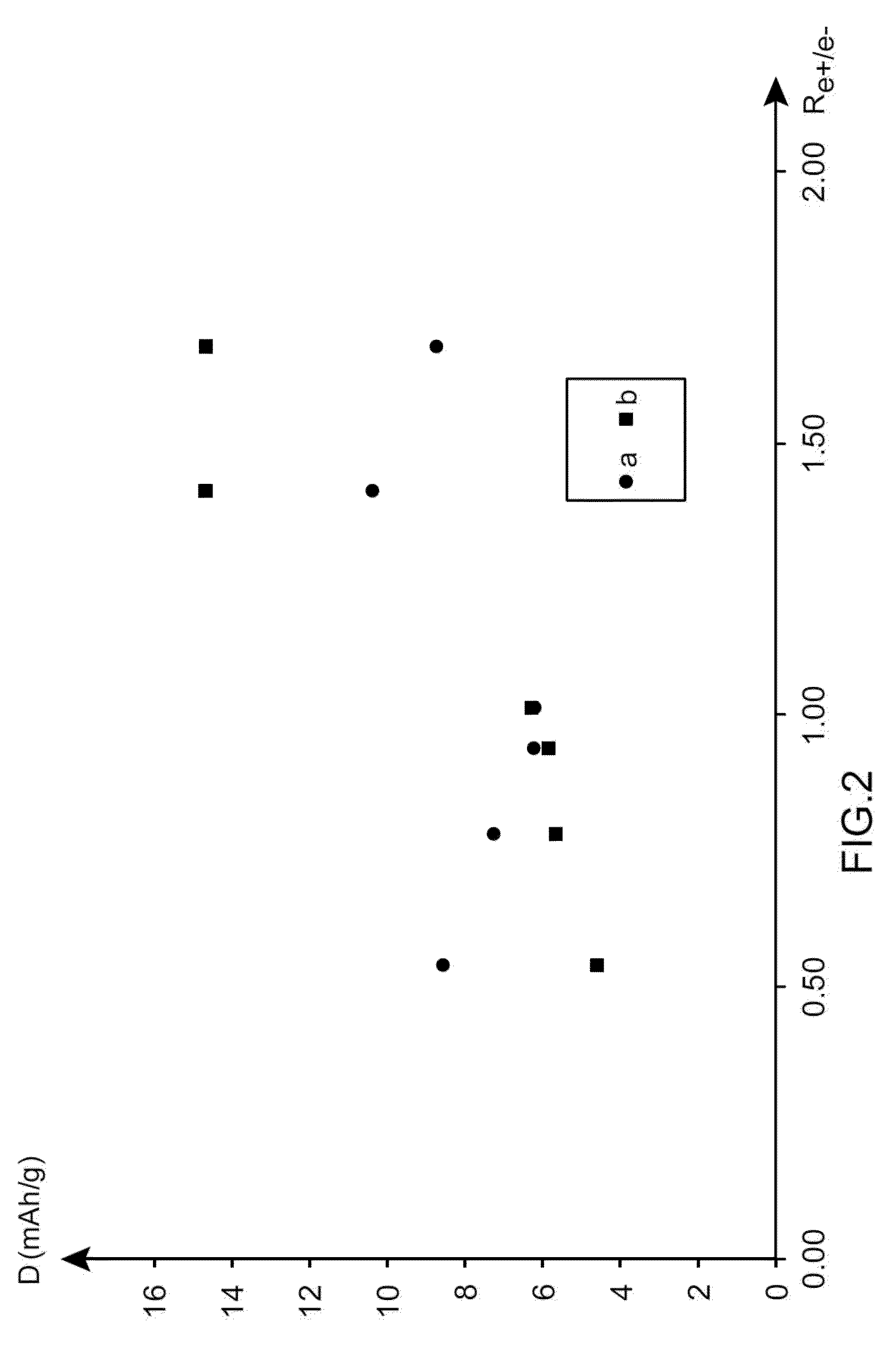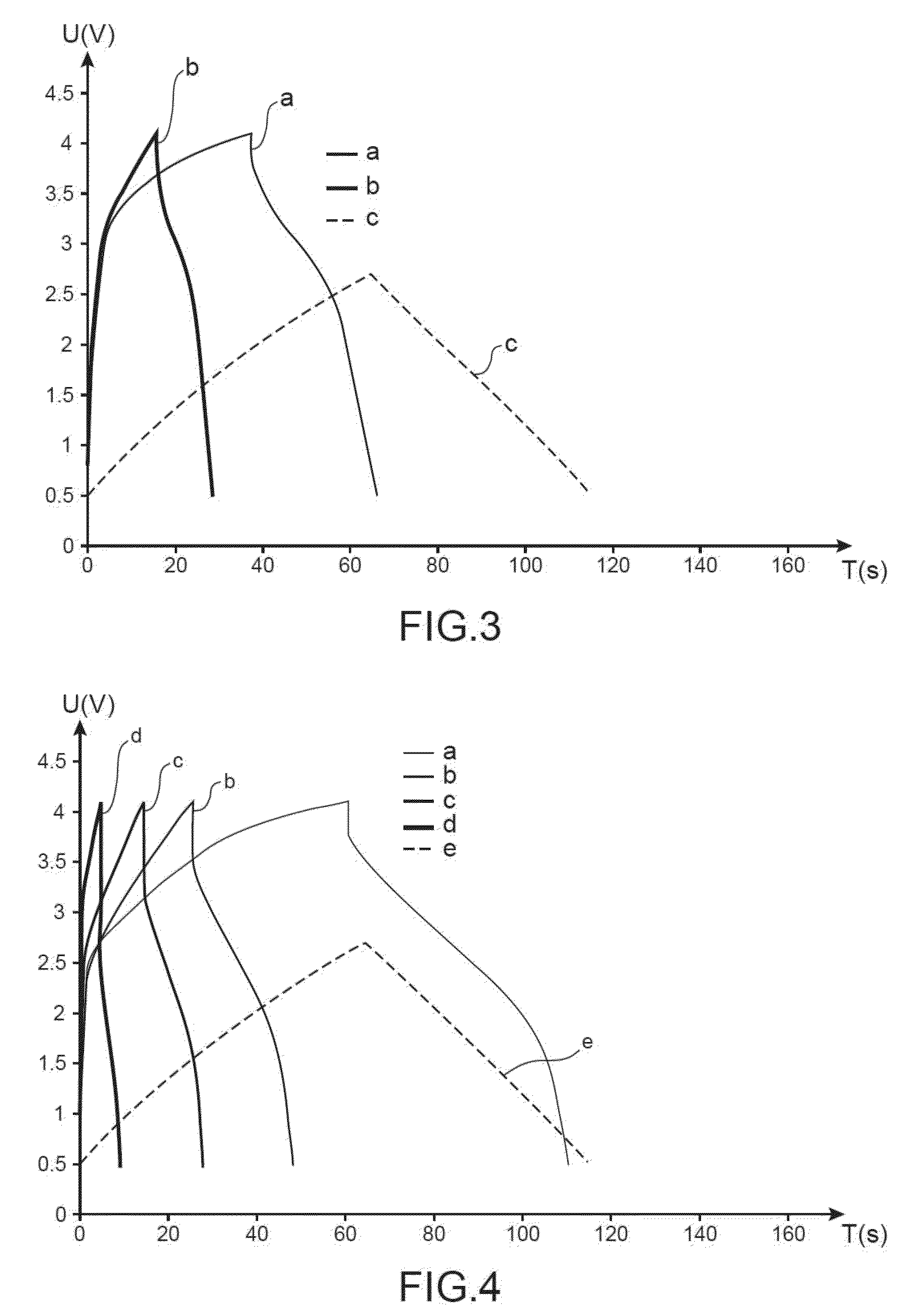Electrochemical supercapacitor device made from an electrolyte comprising, as a conductive salt, at least one salt made from an alkali element other than lithium
a supercapacitor and electrolyte technology, applied in the direction of electrolytic capacitors, electrolytic capacitors, capacitors, etc., can solve the problems of generating significant safety and overcost problems, passingivation layer, non-negligible additional series resistance,
- Summary
- Abstract
- Description
- Claims
- Application Information
AI Technical Summary
Benefits of technology
Problems solved by technology
Method used
Image
Examples
example 1
[0158]This example illustrates the preparation of various power supercapacitors with high energy density in accordance with the invention and, as a comparison, of supercapacitors non-compliant with the invention.
[0159]a) Producing a First Supercapacitor in Accordance with the Invention
[0160]In a first phase, it is proceeded with the preparation of a positive electrode and of a negative electrode.
[0161]The positive electrode is prepared by coating on an etched aluminium collector with a thickness of 30 μm a composition comprising:[0162]84% of activated carbon of reference YP50F (obtained from Kuraray Chemicals Co., Japan);[0163]4% of a styrene-butadiene rubber (obtained from BASF, LD417);[0164]8% of carbon black with reference superC65 (obtained from Timcal Co., Switzerland);[0165]4% of carboxymethylcellulose with a mass average molecular mass of 300,000 (obtained from Aldrich);
[0166]the % being mass percentages expressed based on the total mass of the electrode excluding the current...
example 2
[0230]This example illustrates the preparation of various power supercapacitors with high energy density in accordance with the invention and, as a comparison, of supercapacitors non-compliant with the invention.
[0231]a) Producing a First Supercapacitor in Accordance with the Invention
[0232]In a first phase, it is proceeded with the preparation of a positive electrode and of a negative electrode.
[0233]The positive electrode is prepared by coating on an etched aluminium collector with a thickness of 30 μm a composition comprising:[0234]84% of activated carbon of reference YP50F (obtained from Kuraray Chemicals Co., Japan);[0235]4% of a styrene-butadiene rubber (obtained from BASF, LD417);[0236]8% of carbon black of reference superC65 (obtained from Timcal Co., Switzerland);[0237]4% of carboxymethylcellulose with a mass average molecular mass of 300,000 (obtained from Aldrich);
[0238]the % being mass percentages expressed on the basis of the total mass of the electrode excluding the cu...
example 3
[0284]This example aims at demonstrating the benefit of using, as a solvent, acetonitrile in the devices of the invention with view to giving it good performances, whether the electrolyte is based on a potassium salt (part a) of this example) or on a sodium salt (part b) of this example).
[0285]a) Test Conducted with a Device According to the Invention with an Electrolyte Based on a Potassium Salt
[0286]In a first phase, it is proceeded with the preparation of a positive electrode and of a negative electrode.
[0287]The positive electrode is prepared by coating on an etched aluminium collector with a thickness of 30 μm a composition comprising:[0288]84% of activated carbon of reference YP50F (obtained from Kuraray Chemicals Co., Japan);[0289]4% of a styrene-butadiene rubber (obtained from BASF, LD417);[0290]8% of carbon black of reference superC65 (obtained from Timcal Co., Switzerland);[0291]4% of carboxymethylcellulose with a mass average molecular mass of 300,000 (obtained from Aldri...
PUM
 Login to View More
Login to View More Abstract
Description
Claims
Application Information
 Login to View More
Login to View More - R&D
- Intellectual Property
- Life Sciences
- Materials
- Tech Scout
- Unparalleled Data Quality
- Higher Quality Content
- 60% Fewer Hallucinations
Browse by: Latest US Patents, China's latest patents, Technical Efficacy Thesaurus, Application Domain, Technology Topic, Popular Technical Reports.
© 2025 PatSnap. All rights reserved.Legal|Privacy policy|Modern Slavery Act Transparency Statement|Sitemap|About US| Contact US: help@patsnap.com



